The Best of Both Worlds: Design Tips
I don't pretend to be in any way qualified or credible when it comes to interior design, but there are some basics that just make sense.
Straddling two very different markets - New York City and London - I’ve come to observe and appreciate my transatlantic positioning of what I perceive to be, ‘the best of both worlds’. This is a new category I’ll be adding to my Substack ongoing as I size up the best (and the bad) from both cities - in my humble opinion. First up: Design Tips.
As the renovator of an Upstate farmhouse, there’s a few things I feel need to be addressed and sense checked.
Curtains / Window Treatments
Why do so few American residences have curtains (or window treatments as you like to call them)? Not only do they add texture, warmth and depth to a space, but how do you sleep? Seriously.
1.) Always go longer if you can. Some spaces just lend themselves better to blinds (my farmhouse is a classic example, unfortunately), but wherever makes sense to have curtains, have curtains!
2.) Cafe curtains are not curtains! Cafe curtains are for shielding a beady eye, for privacy, for separating a space from another space, to hide something. They are not curtains. Do not install them like curtains. Also, when installing cafe curtains, the rod goes in the natural break or frame of the window. Measure the curtain to the window, not the window to the curtain! Oh, and if using cafe curtains to conceal shelves or storage areas, make sure they actually block the space. There’s no point installing cafe curtains only for there to be a huge gap in the top between the curtain and the work surface leaving a large peep hole into the very area you’re trying to cloak.
3.) Where budget allows, curtains should always be bespoke - and is where money should be spent. I have had all my curtains made in the UK and I’ve transported these back. It’s been completely worth the investment.

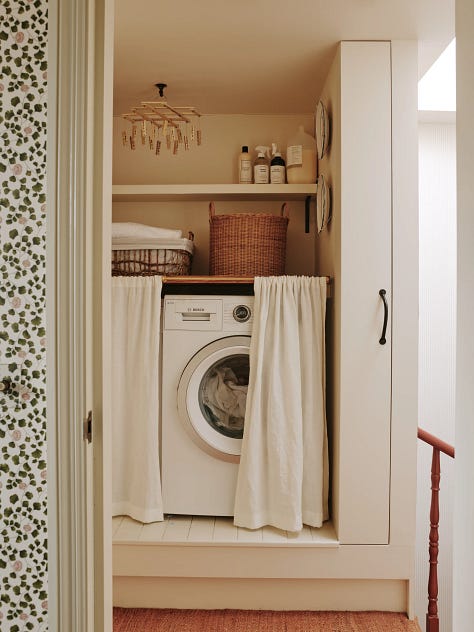

A House Is Never Finished
There’s finished, and then there’s ‘finished’. A part of me loves the American mentality of engaging an interior designer to fit out a new space to completion, from the soap in the bathroom to the fork in the kitchen drawer. But what makes a home yours, is your things; the bits you accumulate over time; the bits with the stories behind them; the bits you buy on holiday. It’s a more European approach to styling. Don’t throw them away and start again each time. A lived-in looking house, is a good looking house. It’s a piece of advice I’m giving myself right now. Rather than looking at something and thinking it’s complete, could you look at something and say ‘what’s missing?’. Does a room need another or different function from it than it did two or three years after you moved in? If so, adapt it.
1.) I don’t do well with clutter. But slowly a book here, a candle there, a decorative plate somewhere are all the layers that start to make a house looked lived in. Collect these as you go through life.
2.) Print scares me. I love a stripe, I love a check, I love geometric patterns. But, I don’t do so well with florals, swirls or ‘scenes’. I love the concept of them, I love when other people do them, but they scare me. Taking things slowly and evolving a house, rather than skeptically throwing everything together at once allows you to figure out what you do like and start to experiment and play with textures and prints.
3.) Art. My good friend Lucy Williams says I have an aversion to art. She’s not wrong. I’m trying to be better but I think art sits in the same camp as prints - do I bore of it too easily? Do I spend too long looking at it? With Lucy in my head, I’ve started to buy a piece here, a piece there - and when you find the right piece, it is amazing how it starts to layer your home and cohere a space. Given the investment, it’s not something to be rushed. Start small (literally).


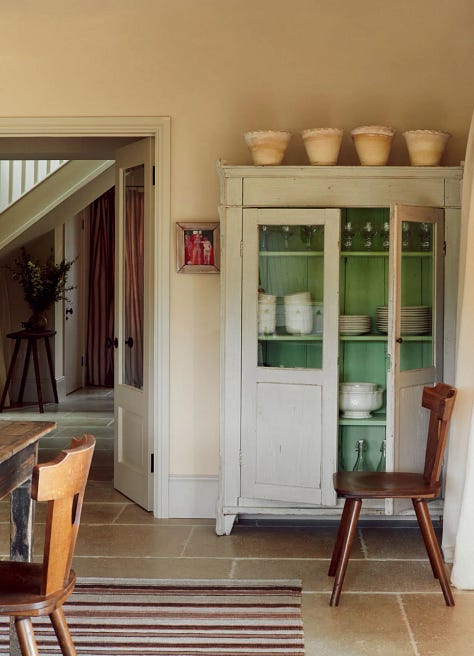
Colour Volume
The Brits love colour, the New Yorkers, not so much. I think there’s a happy halfway house (pardon the pun). A piece of advice my client, Salvesen Graham gave me was to use the same colours throughout the house. That way there’s a uniformity to it and it doesn’t feel quite so loud or aggressive when you move through the rooms. I’ve definitely adopted this in my own house. Farrow & Ball’s No.8 String is both our dining room colour, as well as our dressing area colour. Our brown bedroom (better than it sounds) uses the same colour as the bookshelves in our TV room. Our pink mudroom echoes the pink checkerboard bathroom. It’s not immediately obvious to guests but it creates a quiet flow.
1.) Less choice, less paint. Not only does painting rooms the same colour maintain consistency throughout the house but it also means you’re housing less paint when you need to repaint or touch something up - and yes, do this often.
2.) Paint everything. I’m stealing Lucy (and Ben Reynaert’s) advice again here, but ever since I adopted it, I couldn’t agree more. Paint the whole room - ceiling, trims, windows, the lot. Without a contrast colour to sit against, the colour blends much more quietly.
3.) Sweet Dreams. I have this theory that the colour of your bedroom impacts your sleep. Similarly to how going to bed in a very messy bedroom might impact your sleep (just me?), I feel like too much busyness, pattern or colour volume might over-stir the mind. Ever since we painted our bedroom from white (how we inherited it) to brown, I sleep so soundly. Not only is it warming and cocooning, but it helps keep it dark when the curtains are drawn.



One Room At A Time
Depending on whether you’re decorating a studio apartment in Manhattan or an old English country cottage, this could be very quick, or a rather laborious process. I’m not sure this strategy is adhered to by interiors designers (certainly not American ones), nor is it one they’d suggest, but if you do have the luxury of time (and space), and / or budgets are a consideration, then approaching one room at a time really does pay off. It does mean you have to live with a lot of rather unsightly, unfinished rooms for a long old while, but if you’re happy to explain that (or for us Brits, apologise) to every guest that comes through the front door, do.
1.) Find the flow of the house. Speaking from experience, by living in our house for a while, roles of rooms somewhat assumed themselves organically. We had a strange throughway space between our kitchen and living room. It was full of old cupboards. One day, we ripped off the cupboards doors, crowbarred out the built-ins, painted it a glossy black and suddenly we had a bar. Now, fondly named ‘Boots’ Bar’ after the dog, it’s somewhat of an Upstate drinking hole (and it perfectly blends kitchen to living room)!
2.) Don’t waste money on rooms you know you’re going to structurally or cosmetically change in due course. We have grand plans for our kitchen, and I really struggle to look at our current one, but what’s the point? We put a lick of paint over the putrid yellow the former owners thought was a great idea (it wasn’t), we stuck some plates on the wall, have stacked as many chopping boards and herbs in an effort to make it look ‘farmhouse’ and we grin and bear it. One day… In the meantime, spend the money on rooms that can be completed.
3.) BUT. Having said all that, do consider work that might be best undertaken in an empty house. Sand wooden floors; sand, smooth and prime walls in rooms you know you’re going to paint; do any immediate SOS structural work, demo as much as possible. These jobs can seem expensive when you put them down on paper right from the get go, but it’s money, time and your back(!) saved down the line. If I was being really extra, I’d have someone base coat the whole house in a single colour so at least it felt fresh before you moved in. You’re then ready to paint on top.


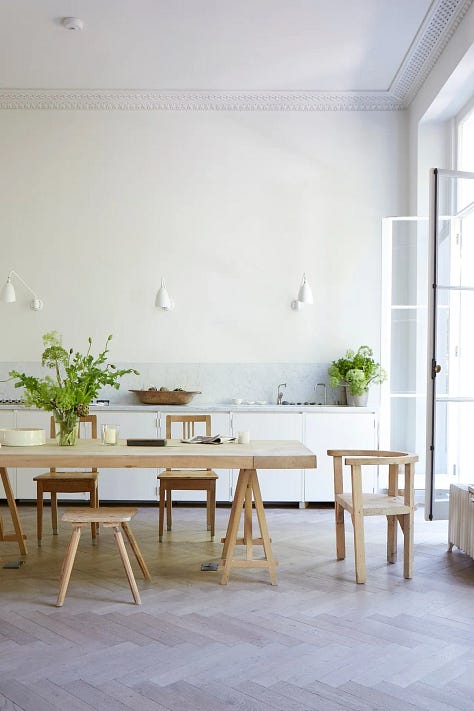
Design For A House, Not For A Style
I see a lot of Upstaters trying to embrace and engineer an English country style in their relatively new build homes. In contrast, I also see a lot of city dwellers designing old farmhouses in a very cold minimalist way. Design for the house you have, not the house you think you have. Be honest with yourself about what your property is, not what you’d like it to be. I made this mistake in our city apartment and a result, it’s a hodgepodge of design with English accents set within a rented, purpose-built, white-appliance modern box. It’s not pretty - and actually ‘pretty’ shouldn’t have been what I was striving for.
1.) Does your intended style match the house? English villages and houses are OLD. Our village church at my parents’ Cotswolds home dates back to the 11th century! ‘English country’ style exists because of the history. This goes hand in hand with ‘a house is never finished’ - these houses have evolved over centuries. If you’re working with a new build, the charm, the character just won’t exude the way you want it to. Similarly, if you’re working with an old farmhouse with temperamental heating and little to no insulation, don’t go in minimalist - add layers and layers of fabric, a plentitude of textures, soft furnishings. Keep in the warmth (and the charm!).
2.) Don’t fake it. Again, don’t try and engineer something that it’s not. For example, don’t add old mouldings to a new property or try and scuff something up so it looks antique. If you’re having to fake it, it’s not meant to be. There is so much inspiration and design options that can be done for every property. Make it interesting and beautiful for what it is. Find the right textiles, be bold (or not) with colour, be creative with layout, buy art - just don’t put lipstick on a pig.
3.) Take inspiration from people who know what they’re talking about. Someone like Jake Arnold (a Brit) has harnessed the English meets modern America look. Reath Design does pattern on pattern, colour on colour in a contemporary, rich way. For those with the right old bones, Meta Coleman is a great example for embracing the ‘full English’ aesthetic within American homes.
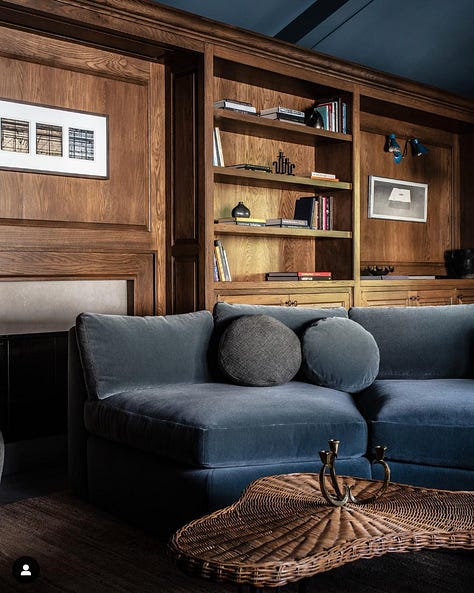

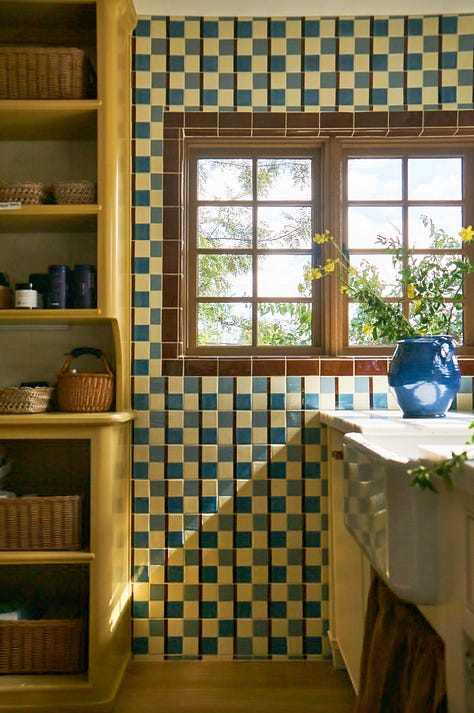
Photos have been sourced from House & Garden, Architectural Digest and designer’s Instagram accounts.




And yes, before anyone comments, I am aware of the typo in the email version. It has been rectified. That'll teach me!